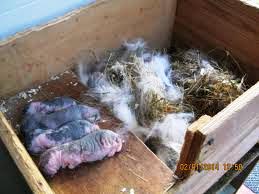Rabbits (Oryctolagus cuniculus) are, like geese and sheep, useful because they eat things that we cannot digest anyway, especially grass. If the doe (sexually mature at 6 months) is mated by the buck she gives birth after a month to a litter with 3 to 10 bunnies (3 to 7 times / year). She makes a nest of hay and chest hair. Keep preferably with your hands off of the newborns (odor!), the doe neurses 1 time per day. After 10-12 days, the eyes are open, and after two weeks the bunnies crawl around. It's going fast in rabbit country. The mating takes only 20 seconds. They breed like rabbits: avoid inbreeding.
 Rabbits are very social animals, but certainly do no put bucks together. They fight.
Rabbits are very social animals, but certainly do no put bucks together. They fight.
If the rabbit gets older and does not have the chance to nibble and dig to keep his nails short, you have to cut them flush with the hairline. They are not rodents, but they gnaw on wood. Their teeth continue to grow. Therefore, they should get enough roughage (hay, twigs). Grass and herbs are fine. Do not give (too) many (soft) fruits and vegetables. Provide plenty of fresh water (make they cannot contaminate or knock over).
RHD (Rabbit Haemmorhagic Disease) is known in Belgium since 1990. The rabbits stop eating and getting bloody diarrhea followed by rapid death, usually with bleeding from the nose and body cavities. Cure is not possible. Vaccination helps.
The myxomatosis virus was intentionally distributed in Australia in 1950, and later in France, to curb rabbits pests. Hm. First you will see a swelling of the eyelids, mouth and anus. Then form bumps (myxomen) all over the body. The rabbit goes sniffling, eyes sticking shut. Because the rabbit cannot eat it usually dies after two weeks.
There is no treatment for the virus, protection by vaccination is possible.
”Rabbits, that 's what I call fast food! “(Patrick White)
